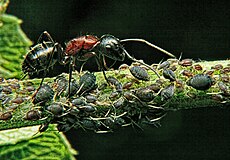
Back Mier Afrikaans Ameisen ALS ጉንዳን Amharic Kakonah AMI Formicidae AN Ǣmette ANG पिपरी ANP نمل Arabic ܫܘܫܡܢܐ ARC نمل ARZ
| Ants | |||||||||||||||||||||||||||||||||||||||||||||||||||||||||||||||||||||||||||||||||||||||||||||||||
|---|---|---|---|---|---|---|---|---|---|---|---|---|---|---|---|---|---|---|---|---|---|---|---|---|---|---|---|---|---|---|---|---|---|---|---|---|---|---|---|---|---|---|---|---|---|---|---|---|---|---|---|---|---|---|---|---|---|---|---|---|---|---|---|---|---|---|---|---|---|---|---|---|---|---|---|---|---|---|---|---|---|---|---|---|---|---|---|---|---|---|---|---|---|---|---|---|---|

| |||||||||||||||||||||||||||||||||||||||||||||||||||||||||||||||||||||||||||||||||||||||||||||||||
| A group of fire ants. | |||||||||||||||||||||||||||||||||||||||||||||||||||||||||||||||||||||||||||||||||||||||||||||||||
| Scientific classification | |||||||||||||||||||||||||||||||||||||||||||||||||||||||||||||||||||||||||||||||||||||||||||||||||
| Domain: | Eukaryota | ||||||||||||||||||||||||||||||||||||||||||||||||||||||||||||||||||||||||||||||||||||||||||||||||
| Kingdom: | Animalia | ||||||||||||||||||||||||||||||||||||||||||||||||||||||||||||||||||||||||||||||||||||||||||||||||
| Phylum: | Arthropoda | ||||||||||||||||||||||||||||||||||||||||||||||||||||||||||||||||||||||||||||||||||||||||||||||||
| Class: | Insecta | ||||||||||||||||||||||||||||||||||||||||||||||||||||||||||||||||||||||||||||||||||||||||||||||||
| Order: | Hymenoptera | ||||||||||||||||||||||||||||||||||||||||||||||||||||||||||||||||||||||||||||||||||||||||||||||||
| Superfamily: | Formicoidea | ||||||||||||||||||||||||||||||||||||||||||||||||||||||||||||||||||||||||||||||||||||||||||||||||
| Family: | Formicidae Latreille, 1809 | ||||||||||||||||||||||||||||||||||||||||||||||||||||||||||||||||||||||||||||||||||||||||||||||||
| Type species | |||||||||||||||||||||||||||||||||||||||||||||||||||||||||||||||||||||||||||||||||||||||||||||||||
| Lasius niger Linnaeus, 1758
Cladogram of subfamilies
A phylogeny of the living ant subfamilies.[2][3] | |||||||||||||||||||||||||||||||||||||||||||||||||||||||||||||||||||||||||||||||||||||||||||||||||

Ants are a kind of insect that lives together in large colonies. They are the family Formicidae.[5][6]
Ants are a lot like bees and wasps. They all originate from the same common ancestor a long time ago, but now have evolved into very different forms, ants being flightless compared to other members of the order Hymenoptera. It is believed that there are about 22,000 different species of ant, but we have only documented approximately 12,500 of them.[7][8][9] Every species of ant has a thin middle segment, known as a thorax, as well as two long rods on their head called antennae.
Ants are social animals, and live in colonies that can range wildly in terms of size. Some species of ants live in small groups, others eat other animals, others still do both. Many ants work together in very large groups to accomplish their tasks. These colonies can have millions of ants in them that travel outside daily over an extremely large area. Ants are small, but they are very strong. Some ants are strong enough to carry things that are as heavy as 10 times their own weight. The most common ant variety is the worker. Workers dig tunnels and carry food back to the colony so that fellow workers and the queen can eat.[10] The Queen is the mother of all the ants in the colony. She is often the only non-worker ant, however, specialty workers such as soldiers or repletes, as well as reproducing ants that are capable of flight known as alates.
- ↑ Moreau CS, Bell CD, Vila R, Archibald SB, Pierce NE (April 2006). "Phylogeny of the ants: diversification in the age of angiosperms". Science. 312 (5770): 101–4. Bibcode:2006Sci...312..101M. doi:10.1126/science.1124891. ISSN 0036-8075. PMID 16601190. S2CID 20729380.
- ↑ Ward, Philip S (2007). "Phylogeny, classification, and species-level taxonomy of ants (Hymenoptera: Formicidae)" (PDF). Zootaxa. 1668: 549–563. doi:10.11646/zootaxa.1668.1.26.
- ↑ Rabeling C, Brown JM, Verhaagh M (2008). "Newly discovered sister lineage sheds light on early ant evolution". PNAS. 105 (39): 14913–7. Bibcode:2008PNAS..10514913R. doi:10.1073/pnas.0806187105. PMC 2567467. PMID 18794530.
- ↑ Brady, Seán G; Fisher, Brian L; Schultz, Ted R; Ward, Philip S (2014). "The rise of army ants and their relatives: diversification of specialized predatory doryline ants". BMC Evolutionary Biology. 14: 2–14. doi:10.1186/1471-2148-14-93. PMC 4021219. PMID 24886136.
- ↑ pronounced /fɔrˈmɪsɨdiː/). The word ant comes from ante, a Middle English which comes from æmette of Old English and is related to the Old High German āmeiza. All of these words come from West Germanic *amaitjo. It meant "the biter" (from *ai-, "off, away" and *mait- "cut"). ""ant". Merriam-Webster Online Dictionary". Merriam-Webster. Retrieved 6 June 2008.
- ↑ "Ant. Online Etymology Dictionary". Retrieved 30 May 2009. The family name Formicidae is from the Latin word formīca ("ant"). Simpson DP (1979). Cassell's Latin Dictionary (5 ed.). London: Cassell Ltd. ISBN 978-0-304-52257-6. The word "ant" in other languages such as the Portuguese formiga, Italian formica, Spanish hormiga, Romanian furnică and French fourmi come from the Latin word.
- ↑ Bolton, Barry (1995). A new General Catalogue of the Ants of the World. Harvard University Press. ISBN 978-0-674-61514-4.
- ↑ "Hymenoptera name server. Formicidae species count". Ohio State University. Archived from the original on 2008-06-18. Retrieved 2010-12-06.
- ↑ La nueva taxonomía de hormigas. Pages 45-48 in Fernández, F. Introducción a las hormigas de la región neotropical (PDF). Instituto Humboldt, Bogotá. 2003.
{{cite book}}: Cite uses deprecated parameter|authors=(help) - ↑ Wade, Nicholas (15 July 2008). "Taking a cue from ants on evolution of humans". New York Times. Retrieved 15 July 2008.